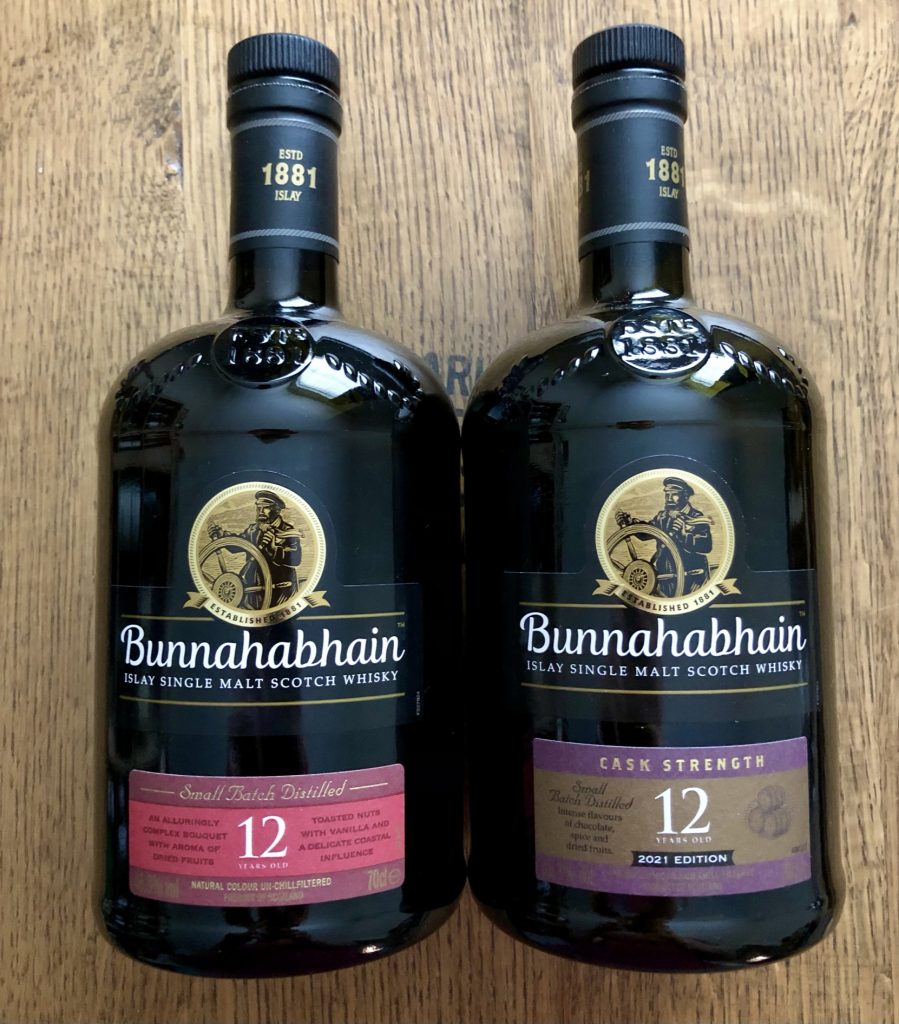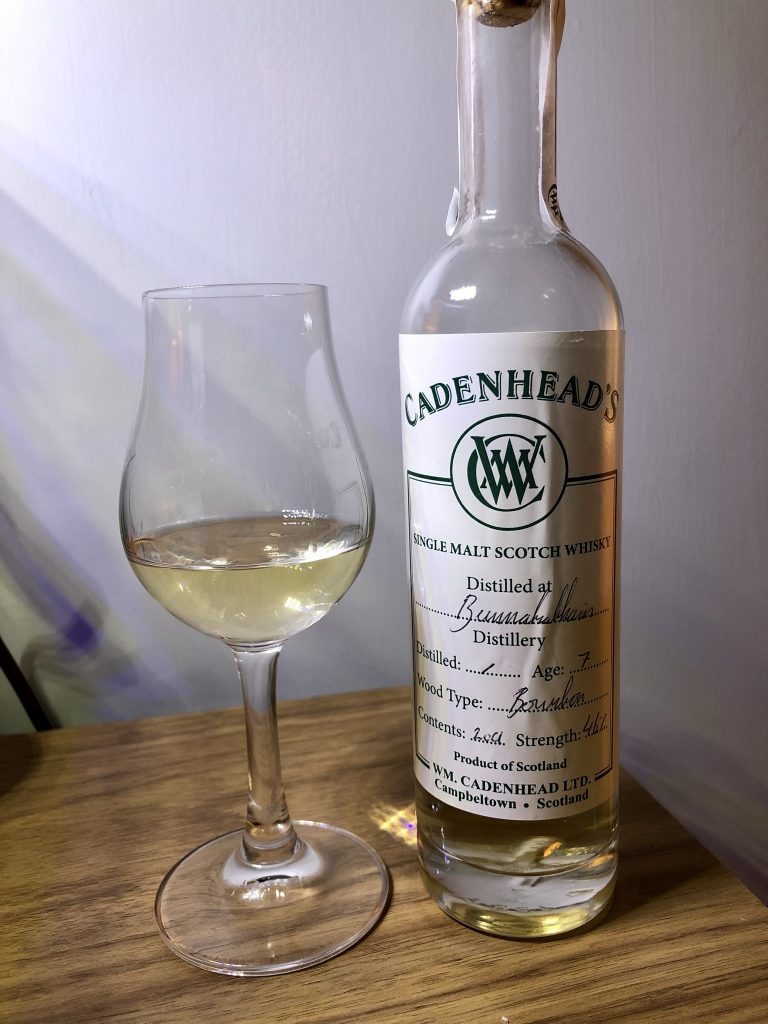Bunnahabhain 12 (46.3%) v Bunnahabhain 12 CS (55.1%)
The Battle of the Bunna’s

The announcement that Distell were to release a cask strength version of their ever popular 12 year old from Bunnahabhain was met with delight by many. That delight became a little lukewarm for some when they heard it was going to be £75 a bottle for only 8.8% more alcohol than the standard 12, which can often be had for less than £40; I think my last two bottles were £30 each. While I tend to agree and would have liked to see it come in a little cheaper, its not extortionate in today’s market for a cask strength twelve year old, and I was more than keen to buy a bottle and give it a try. Although it still needs to impress me to warrant another bottle somewhere down the line.
Trying a cask strength version alongside a lower ABV is likely to come to one conclusion, with the cask strength being the superior whisky, but that’s not necessarily the case when we come to look at the difference in cask maturation between the pair. Also, even if the cask strength is the better, what I really want to discover is how it is better, and whether it justifies being around twice the price of the standard offering.
The cask strength is the first of what will be an annual release from the distillery, and the 2021 is fully matured ex-sherry casks. The type of sherry and the proportions of first-fill, second-fill etc. is not detailed from what I can see on the website or packaging. The inspiration comes from tastings straight from the cask at the distilleries warehouse no.9, an experience that many visitors speak fondly of. The standard 12yo is double-matured in ex-bourbon and ex-sherry casks. So right off that bat, we know that this isn’t a simple case of the same liquid being presented undiluted. Sherry casks also tend to be more expensive than bourbon, so that could go some way to explaining the difference in the pricing. Let’s get tasting.
Bunnahabhain 12 Years Old 46.3%
Colour : Gold
Nose : Light toffee, with sweet and sour apple, blackcurrant and raisin. There’s gingerbread and cinnamon spice along with a small, but noticeable rubber note. Musty wet autumn leaves, yeasty breadiness with grasses and sea spray.
Palate : Sweet toffee and brown sugar at first, but soon after we get sour apple, sweet red fruits and lemonade. It then starts to move towards bitter, with drying oak, fresh ginger, tea and a creamy nuttiness. The bitterness remains, but fades somewhat in the drying finish along with the ginger and nuts.
Conclusions : There is a good balance between the bourbon and sherry casks, and the apple and blackcurrant reminds me of the fruit cordials I used to drink as a child. The oaky bitterness at the back end is the only slight let down for me, but it is nevertheless a mostly positive experience.
Bunnahabhain 12 Years Old Cask Strength 55.1%
Colour : Rich Gold
Nose : Sweet toffee and butterscotch, along with bitter coffee and cocoa are immediately apparent, with a burnt rubber note. A few drops of water reveal demerara sugar and bring more of the fruit notes to the fore, such as raisin, blackcurrant and orange peel. We get some spice in the form of nutmeg and clove. There’s a subtle waft of musty leaf litter, and some honeycomb and vanilla to round things off.
Palate : Thick and coating on the palate, with an oiliness on the lips. Echoes of the nose with the sweetness coming from salted toffee and dark sugar notes, and the coffee and hint of burnt rubber present also. There’s dried red fruits soaked in lashings of sweet sherry, with gingery spice and rich oak. The oak is quite drying and bitter and carries on through the rest of the development, but sweet Christmas cake flavours remain. In the finish we get a creaminess along with an almond nuttiness.
Conclusions : The nose in particular is very good here and the mouthfeel is excellent too. I enjoy the palate with its dark sugars and coffee along with the dried fruits, but find the oaky bitterness lingers a little longer than ideal for my liking. Judging from the appearance in the glass and the tasting, I suspect there is a combination of first-fill and re-fill sherry in the mix. Overall a decent dram.
Overall thoughts : Visually, there is a subtle, but noticeable difference in colour in the glass, with the cask strength being the slightly darker of the two. I have gone for gold and rich gold for my descriptors. The distillery say russet and deep russet gold, not that it matters too much.
The cask strength has more body and a thicker mouthfeel, which isn’t too much of a surprise, and it’s oily on the lips in a way the core range version isn’t.
On the nose the cask strength is bigger and bolder than the lighter and more delicate core range 12. There’s more toffee, bolder fruit aromas and more of the rubberiness. I like that rubber, and it is not as overt as some sherry matured whiskies can be. Both have the damp autumn leaves thing going on, but more so on the standard 12.
On the palate, the cask strength has a noticeable alcohol nip when it hits the tongue, but not unpleasantly so, and it can be tempered by the addition of a little water. That isn’t something I find with the standard 12. Although we are getting the sweet toffee in both glasses, the cask strength is sweeter and much more rich. Both have a lingering oaky bitterness at the back end, which isn’t ideal for my taste, but far from a disaster. It is more apparent with the cask strength version.
Overall, whilst there are similarities, I think we are dealing with two noticeably different whiskies, which is important when deciding if the cask strength version is worth purchasing. It would be a mistake to think this is the same whisky with ABV being the only change. If you like a sweeter, richer and more sherry cask influenced experience, then you want to be looking towards the cask strength offering. For the fans of a lighter and more delicate dram, you may well prefer the standard core range dram.
As for my personal preference, as I write this on a cold January evening, there is something warm and comforting about the sweet, rich sherry flavours in the cask strength. I’m a sucker for a decent mouthfeel too, and this one is thick and luxurious. However, the core range twelve is still a whisky I enjoy and am happy to have on the shelf, and at half the price it is certainly better for the pocket. It will be interesting to see if the second release later this year is a carbon copy of 2021, or if they will try and mix things up a bit.
Let’s have a bonus Bunna to finish things off. Considering Bunnahabhain is well known for being the Islay distillery that doesn’t normally use peat, the peated Staiosha independent bottlings have been some of my favourite, so let’s check out this young offering from Cadenhead’s. This is matured entirely in ex-bourbon casks and was released in early 2021 I believe. I am not sure it is available online any more, but I picked up a 20cl bottle from the shop in Edinburgh last October. If you are ever up that way, i’d recommend the decent selection of 20cl bottles they have on the shelf with hand written labels; I should have picked up more.
Bunnahabhain 7 Years Old Peated Cadenhead’s 46%

Colour : White Wine
Nose : Tons of salty maritime peat strikes first, with smoked mackerel served with a big wedge of lemon. Dried herbs (sage and basil) and antiseptic cream.
Palate : It’s an earthy, salty, minerally hot pebbles on a beach kind of thing at first, but then it turns ashen and more like a bonfire. Then we start to get citrus lemon and foam bananas, along with some icing sugar. It’s a little meaty too, with charred brisket and peppered salami. As the development continues, we get some vanilla cream. The finish remains ashen, with more of the cream and salt.
Conclusions : As for the whisky, the nose is good, but the palate is the real winner here, which is something I don’t get to say often enough. I like the way the peat influence develops from earthy to ashy, along with those confectionery and meaty notes. This is the style of Bunna I really like, and brings out the maritime nature of the distillery.
